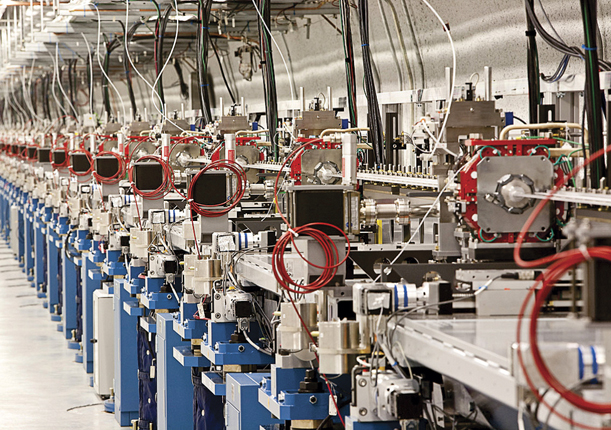SLAC x-ray user facility to be updated, again
DOI: 10.1063/PT.3.2141
An upgrade of the Linac Coherent Light Source (LCLS) at SLAC will provide new experimental capabilities in time-resolved physics, chemistry, and biomolecular research fields. The Department of Energy is currently reviewing a plan SLAC submitted that the lab says will, among other things, let experimenters create more detailed motion pictures of the making and breaking of chemical bonds.
Based on recommendations from the Basic Energy Sciences Advisory Committee (BESAC), the project would modify the LCLS-II, an already approved upgrade to the LCLS that is supposed to begin construction in fiscal year 2014, assuming Congress appropriates the funding. A BESAC report released in July urges DOE to build “an unprecedented x-ray light source” that would leapfrog the capabilities of any other free-electron laser (FEL) x-ray source being built or planned worldwide. The report bluntly warns DOE that failure to build such a machine would cause the US to lose its 40-year leading role in light sources. It is “abundantly clear,” the panel says, that new FELs being built or planned in Europe and Asia “will seriously challenge U.S. leadership in the decades to come.”
The BESAC report says, “The highly successful experience with LCLS (and other facilities around the world) provides an understanding of the technical possibilities of sophisticated FELs. This window of opportunity is well established. Revolutionary new science would clearly arise from a facility with these photon characteristics,” which include femtosecond-long x-ray pulses at high repetition rates.
DOE concurs
“We agree that a light source facility with the characteristics noted in the BESAC report is necessary to maintain US leadership in x-ray sources in the future,” says Harriet Kung, associate director of science for Basic Energy Sciences. “We are working closely with SLAC as the project team considers options.”
In written responses to questions, SLAC director Chi-Chang Kao said, “Ultimately we expect LCLS-II to incorporate the capabilities called for in the BESAC subcommittee report.”
The report, Kao wrote, urges SLAC “to go beyond the capabilities that we originally envisioned for LCLS-II, so as to enable a broad range of new experiments—some of which would require high intensity and very short pulse duration—and another class that would require a high rep rate and lower intensity pulses.” John Hemminger, BESAC chair, says the LCLS-II could increase its repetition rate with the addition of multiple superconducting undulator magnets.
Although the LCLS already has some capability to assemble a series of images into a movie of chemical reactions, that capability can be enhanced, Kao said.
Lawrence Berkeley National Laboratory had presented BESAC with a plan to upgrade its proposed FEL, called the Next Generation Light Source (NGLS). But a spokesman for LBNL said the lab had withdrawn its proposal and was joining SLAC’s upgrade effort.
Hemminger, vice chancellor for research at the University of California, Irvine, says he believes the BES budgets for the coming years have sufficient funding to cover the cost of the recommended upgrade.
The LCLS was the world’s first hard x-ray FEL and Japan’s Spring8 is the only other FEL that operates in the hard x-ray spectrum. The original LCLS-II was scheduled for completion in 2018. Kung says it is too soon to say when the BESAC-recommended upgrade would be completed. Three other hard x-ray FELs are under construction in Germany, South Korea, and Switzerland. Soft x-ray FELs are already operating in Italy and Germany. In the US, the soft x-ray NGLS was the only other FEL source in the planning stages.
By 2020 Europe will have the most advanced suite of light source tools in the world in terms of capability and capacity, the BESAC report says.
New classes of experiments
What would set the proposed facility apart from other FEL sources is its high pulse-repetition rate and broad photon-energy range. Femtosecond-long x-ray pulses would enable rapid-fire imaging of dynamic processes in chemistry, physics, biology, and materials science. Such experiments, says the BESAC report, include time-resolved physics and chemistry studies of how bonds break and form, how energy flows at the molecular level, and how charge is transferred in nanoscale electronic devices. The x-ray source could perform two new classes of biomolecular experiments, one destructive and the other nondestructive. The first, which the panel calls “diffract-before-destroy,” takes advantage of the fact that femtosecond pulses can outrun radiation damage. The second class, pump–probe, uses two or more pulses per sample to study dynamics. It must be nondestructive to allow repeated measurements using subsequent pulses on the same sample. Those types of experiments have already revolutionized spectroscopy in other regions of the electromagnetic spectrum, Hemminger says.
In its report, BESAC also urges a “robust R&D effort in accelerator and detector technology that will maximize the cost-efficiency of the facility and fully utilize its unprecedented source characteristics.” It notes that a large class of experiments conducted at a new light source will involve maximum data rates exceeding 1010 x rays per pixel per second, and that other experiments will require recording an enormous dynamic range of 106 across the detector. X-ray detectors must be capable of capturing that span of data in each image while framing at kilohertz to megahertz rates. Greatly increasing the framing and readout rates of imaging x-ray detectors would allow movies to be made for studies of nonreversible processes.

The Linac Coherent Light Source at SLAC. The Department of Energy is likely to approve a modification to the LCLS that would make it the world’s most advanced free-electron laser x-ray source.
SLAC

More about the Authors
David Kramer. dkramer@aip.org
